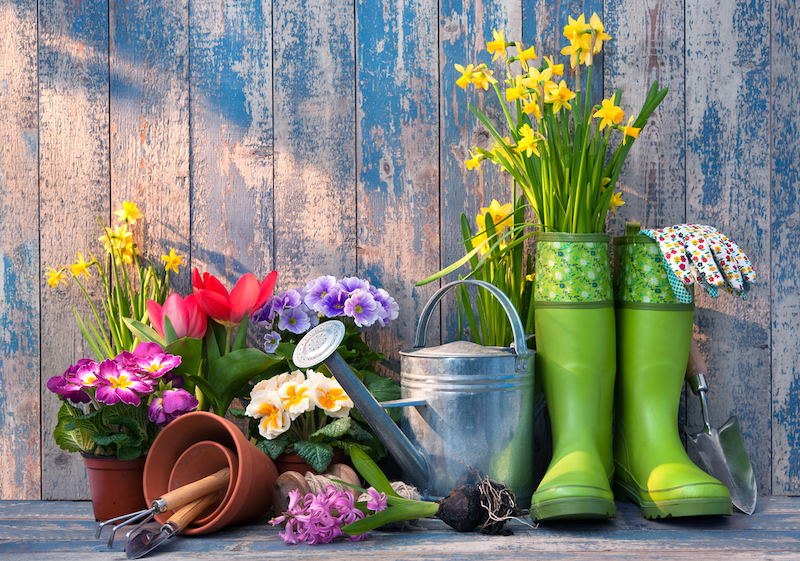Preparing your garden for spring will keep you busy and provide months of rewarding flowers and vegetables.
RELATED: 15 DIY Spring Garden Projects You Should Start Doing
How To Prepare A Garden For Spring
When To Prepare For Spring Gardening
You can start preparing for your spring garden a couple of weeks before spring starts. There are no strict rules when it comes to garden preparation, it’s never too early or too late.
There are, however, things to bear in mind:
- Planning
- Ideally, you will plan your spring garden well in advance. You can start planning your garden while it’s still chilly outside.
- Decide what vegetables or flowers you want to plant and create a gardening calendar.
- This gives you a good idea of when to start other preparations, like soil maintenance.
- Clean up and general maintenance
- If you’re eager to start gardening after months of being indoors, you can start cleaning up your garden shed while it’s still too cold to start gardening. You should also clean and sharpen your gardening tools.
- Weeding and pruning
- Weed your garden right before you start soil preparations. Make sure you remove all the weeds to ensure the success of your garden.
- Prune back shrubs and trees in late winter or early spring while plants are dormant.
- **If you live in an area prone to late winter frost wait a bit longer before pruning. Fronts will damage the exposed cuts and harm your plants.
- Soil preparation
- Start preparing the soil 2-4 weeks before planting. Usually, right after the frost has lifted works out perfectly for this timeline.
- Another way to check if it’s time to till your garden is to take a handful of soil and squeeze it into a ball.
- If the soil breaks apart easily when dropped, it’s time to start preparing the soil. If it doesn’t break apart easily, wait another week or two.
- Working the soil too early or too wet is not only difficult but also risky. It makes the soil more compact and your plant may struggle to grow.
- Add nutrients to the soil after tilling. Use fertilizer compost or grass cuttings for nutrient-rich soil.
Spring Flower Beds
Spring flowers are the embodiment of life and new beginnings. They can also attract insects and birds to your garden.
Keep the following in mind when preparing your spring flower beds:
- Plant bulbs
Spring flowering bulbs are wonderful flowers for your garden. They require little maintenance and they’ll pop up during spring for as long as you take care of your garden.
- Use containers and planters
You can start your spring garden earlier if you use flower pots and other containers because you can move them to the shed at night They also add dimensions and height to your flower bed.
- Choose early-blooming flowers
Flowers can take longer to bloom in colder climates, which leaves a shorter flowering period and makes winter feel longer.
Bleeding heart, creeping phlox and bloodroot sound like something from a horror film but these are all early bloomers that are perfect for a spring garden.
- Choose the right plant for the area
Some plants require more direct sunlight or more shade. This can impact how much they flower and how long they live.
Also consider when choosing plants.
Spring Vegetable Garden
Fresh homegrown vegetables taste so good and it can save you money. A little planning and commitment go a long way and the result will definitely be worth the effort.
For the best spring garden:
- Plant seeds indoors
Reuse household items like egg cartons, ice trays, and toilet paper rolls to grow seeds indoor the weeks leading up to spring. This gives your veggies a leg up and produce will be ready to harvest sooner.
Fill containers ¾ of the way to the top with seed-starting mix. Follow the planting instructions on the seed packet and wait for your seeds to grow.
You can cover the containers with some clear plastic until the seeds have germinated. The plastic helps keep the soil moist and acts like a miniature greenhouse, trapping some heat.
Find a sunny spot for the seedlings or grow them under a fluorescent light. Seeds require daily temperatures above 65 degrees to germinate. Keep them on a heated pad if you’re concerned about the temperature.
Once the seedlings have some leaves they’re ready to be planted in the garden. If winter lasts longer than expected, transplant your vegetables into larger containers until it’s warm enough outside.
- Consider going organic
Organic gardening healthier and better for the environment than conventional gardening. And it’s a lot simpler than people think.
Organic gardening starts with well prepared nutritious soil. Find the right spot in your garden with enough sun and access to water, and that’s basically all you need.
- Grow companion plants together
Have you ever heard of the three sisters? Native Americans use to grow beans, corn, and squash together because they help each other grow better.
Some plants take up nutrients from the soil while others put nutrients back. By growing vegetables in the right combinations you’ll keep your plants fed and the soil healthy.
Companion plants make the most available space and deter pests.
For spring plant broccoli, cabbage and beets together. Spinach and peas also make excellent spring vegetable companions. Lettuce, garlic and onion can also be planted together in spring.
- Plant enough, not too much
Unless you plan on selling or pickling vegetables, don’t plant too much of one thing. Rather plant a greater variety of vegetables.
Knowing how much of each to plant is tricky. There is no way to calculate exactly how much you should plant.
Some factors to take into consideration include available space, family size, and how often you’ll be eating it.
If you do end up having too much, pickling and preserving may become your new favorite hobby.
It’s never the wrong time to start a garden but starting in spring is so much better. The new life in spring can lift your spirits after months of cold. And with some planning and dedication you can have a beautiful garden this spring that will bring you months of joy.
How do you prepare your garden for spring? Let us know in the comments below!



